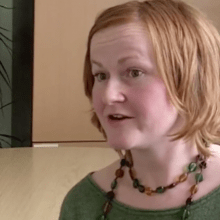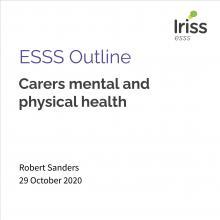Dr Susan Elsley talks about research commissioned by NHS Scotland, which aimed to contribute to the development of mental health indicators for children and young people in Scotland, which has recently been launched: mental health indicators for children.
The consultation included reaching a wide range of children and young people from a variety of different backgrounds, this included children and young people: with disabilities, learning disabilities, who have experience of being in care, those from black or minority ethnic communities and very young children. NHS Scotland gathered their views on 7 cross cutting themes that were adapted for young people from the adult mental health indicators. These included: fun, not fair, being heard, healthy, people, places and community.
The high level findings included that:
- children and young people do not feel that they are consistently listened to,
- older young people have quite significant experience of stigma and discrimination
- family is important to children and young people, but this can often depend on the person's circumstances
The consultation found that the views of what was important to the well-being of children and young people was in line with the draft mental health indicators. The consultation also highlighted that some factors are worth further exploration - such as the importance of play and the experience of stigma and discrimination.
Read the consultation documents
A link to a shorter briefing on the consultation, Doing ok? Children and young people's views on what affects their mental health (PDF), published by the Centre for Research and Families and Relationships (CRFR), University of Edinburgh, is also available.
Susan Elsley, recorded January 2012
SE So this piece of research was commissioned by NHS Health Scotland, and it was part of a programme of work developing mental health indicators for children and young people, and this was built on a programme that was already there for mental indicators for adults. So part of the programme was to draw on a whole variety of evidence and research and policy, and this included finding out about the views of children and young people.
NHS Health Scotland had already commissioned a Literature Review to look at the research which gathered the views of children and young people on mental health, and what they found was there were a number of gaps. And the aim of this consultation was to actually fill some of those gaps. Now those gaps were there was less research around mental health and wellbeing around younger children and around particularly socially excluded groups. So NHS Health Scotland commissioned the Centre for Research on Families and Relationships to undertake consultation with children and young people.
So this consultation was undertaken between March 2010 and May 2010, and the aim was to gather the views of children and young people in specific groups. So we looked at the views of children and young people who were disabled, and we had a group of young deaf young people and young people with learning disabilities. We also gathered the views of children and young people in minority and ethnic communities, including young gypsy travellers, and young people with experience of care. So we talked to some young people who had moved on from care. And we also talked to young children, and we talked to three and four year olds and children between five and eight.
So during the period of the consultation we spoke to 70 children and young people and what we aimed to do was not ask them about mental health, but what were the things that made them feel okay and not okay - and that was because often the terms around mental health, mental ill health, mental wellbeing - they are kind of alien to children and young people. And we wanted to actually encourage them to think about the things that contributed to their wellbeing in their everyday lives. So doing this, we actually took some of the cross-cutting themes that had been used by the National Steering Group for the Development of Mental Health Indicators, and we adapted them for children and young people. So we took the themes and looked at fun, at what was not fair, at people, at places, at community, being heard and health. And those were the 7 cross-cutting themes that we took. And to do this, we didn't have a lot of contact time with children and young people - we were often talking about one or two sessions with children and young people. So we needed a method that was going to gather their views very quickly and efficiently and allow them to contribute effectively.
So what we did was we developed a big poster which had these different cross-cutting themes on, and then we facilitated a discussion in a group with young people using speech bubbles and clouds to capture some of the things that they talked about. So we talked to children and young people about the different cross-cutting themes, and a number of common themes emerged from it. One was that having somewhere to go, to play, to have access to leisure was extremely important for all children and young people. Access to online communication, particularly for older young people, was very important. But some young people, particularly young gypsy travellers and young carers and young people who had move on from care highlighted that they didn't always have access to the play and leisure that they wanted - either because of financial issues or because of discrimination or because of caring responsibilities.
In terms of children and young people being heard, young people had a fairly consistent message which is in line with lots of other research and consultation, which was that adults were a bit inconsistent to listening to children and young people. Some did it very effectively, and some didn't. So it was ... their message was that children and young people were not being listened to all of the time when they required it. But families, parents, brothers, sisters, relations were very important in terms of listening to children and young people, and other professionals such as teachers, social workers ... and youth workers were particularly highlighted as being very important in terms of listening to children and young people. But young people also flagged up occasions which were quite crucial to them, when they didn't feel that they were listened to.
In terms of other areas, in terms of the important people in their lives - well it is unsurprising that family and friends and people that are close to them are very important. But young people who had moved on from care - they didn't actually talk about their families in the same way as other young people. For young gypsy travellers, the family and the extended family was particularly important.
The cross-cutting theme - 'not fair' - that elicited general comments from all the children and young people, and the young ... very young children, the 3 or 4 year olds, were very able to understand the concept of 'not fair'. Younger children talked about being bullied, cheating in games, things that they thought were unfair in the home, whereas some of the older children and young people talked more about stigma and discrimination that they experience. So for young carers, for example, they talked about in school, teachers not being fully aware of their needs. Young people who were gypsy travellers highlighted that they experienced very high levels of discrimination, as did young people who were deaf highlighted that in certain situations they weren't listened to adequately. So stigma and discrimination, particularly for some of the older children and young people, was a significant issue.
In terms of places, it is unsurprising that outside places such as play parks, places to go, having something to do were very important, as well as more standard things of at home and at school. And for different people, that meant different things. For a gypsy traveller, they talked about the importance of family obviously, but also talked about the fact that their lifestyles were often different and that was not always well understood. So places really kind of were important for a wide range of issues, reasons, but there was ... and this is in line with kind of standard research.
In terms of being healthy, this is such a wide topic that children and young people talked about the public health messages that they were aware of, whether that is eating healthily, having exercise, cleaning their teeth, etc. But that wasn't explored in so much detail because it covered such a wide range of areas, except for those children and young people who had more contact with primary healthcare because of their families or their own needs.
And the final area was around changes, and here children and young children talked about the different transitions in their lives. For younger children like the 3 or 4 year olds, obviously going up to nursery was a big issue. But for some children and young people, transitions were difficult because they had been in care or because of the challenges involved in their own lives. So that was a quite ... a very complex area, but something that was quite significant. So that's the kind of broad themes that emerged from these 7 different areas, so the top line messages are that children and young people feel that they are not consistently being listened to, that some groups of children and young people, particularly older children and young people experience stigma and discrimination, and that families are very important to children and young people, and that depends a lot on their personal circumstances.
Now the aim of the consultation was to feed into the Mental Health Indicators that were being developed at that time and to see if the various ways of organising those Mental Health Indicators and the content of them actually matched with children and young people's needs and perspectives. Broadly, it appeared that children and young people's views and the things that are important to them actually were in line with many of the things that were in the draft Mental Health Indicators at that time. But what is striking is that there are some areas that seem to be worthy of further exploration, either in terms of Mental Health Indicators or in terms of research and consultation generally. In terms of play, there appears to be an opportunity to develop more research and consultation around the importance of play around children's wellbeing, and in the area of stigma and discrimination, because it came through quite significantly, that seems to be a very powerful issue that could be explored for children and young people.
What has happened now is that the Mental Health Indicators, the work on the Mental Health Indicators has completed, and they were lodged by NHS Health Scotland in November 2011. So they are available now on the NHS Health Scotland website - if you Google 'mental health indicators for children and young people', and you will come up with the final briefing on the Mental Health Indicators, along with a whole variety of other tools and reviews that were undertaken during the development of the Mental Health Indicators. And on that site you will find 3 different reports around work with children and young people - one is the full (... unclear) report that was produced for NHS Health Scotland, one is a briefing 'Doing Okay' which was produced by the Centre for Research on Families and Relationships and also a Young People's Summary that was produced at the same time.










